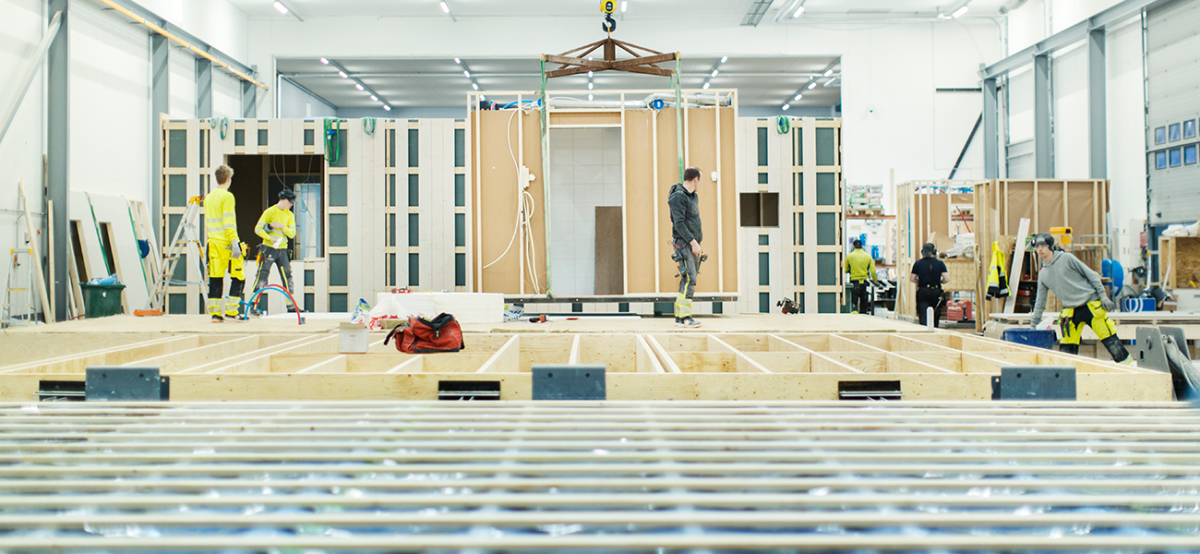Environmentally sustainable construction is not possible unless we identify the environmental impact of the material flows throughout the building’s life cycle. Puukoti, which aims to be a forerunner in ecological urban living and industrial wood construction, decided to rise to the challenge and analyse the climate effects of the material flows of modular construction as a whole. Their partner in this ambitious project is Kiilto, and the aim is to make environmental accounting part of everyday business.
Since the start of operations in 2000, Puukoti has built more than a thousand homes in semi-detached houses, balcony access blocks and terraced houses. The company’s mission is to build a society in which good living is affordable to as many people as possible. Good living is not achieved by accident. The amount of pre-construction background work is massive, and it mostly comprises various calculations. Knowledge-based decision-making is required to achieve the goals.
Understanding environmental impact is an integral part of good living
Good living usually entails conceptions of quality and durability. In other words, environmental aspects are closely associated with good living. So far, environmentally conscious consumers have been able to select ecological building and decorating materials, energy efficient appliances or high-end energy solutions for their home. Awareness of the Nordic Swan Ecolabel for construction based on a life-cycle approach has increased in recent years. Both the industry and end users have a better understanding of the environment now. In the future, a building’s carbon footprint will probably be one of the deciding factors in choosing a home.
The cooperation between Puukoti and Kiilto takes environmental awareness even further. Environmental accounting is used to analyse emissions during construction and the carbon footprint of the selected solution, assess the environmental impact of all materials during construction, and examine the possibilities for carbon storage and sequestration with Puukoti’s solutions.
“We want to know the exact amount of emissions each material generates during its life cycle. In order to study which solutions are better for the environment, we need a more holistic understanding of the overall effects of our solutions. Environmental accounting also lets us steer our priorities towards the biggest sources of emissions and search for new solutions while we minimise the environmental effects as efficiently as possible. We will begin the systematic monitoring of our CO2 emissions and set an ambitious goal for reducing our carbon footprint,” says Antti Seppinen, Commercial Director at Puukoti.

Image: Puukoti Group Oy
Legislation pending
For many years, Kiilto has made great efforts to apply environmental accounting to its products and solutions. This is a new aspect of its service. However, the need for environmental accounting keeps increasing as the construction industry is reformed along with the related legislation. The same trend can be seen in all the Nordic countries and, for example, Denmark will be introducing CO2 emission limits for buildings in its legislation next year. The emission limits will be tightened throughout the decade. A similar model is being planned for Finland, as well.
Reform is the key to survival for businesses in the industry, as well as for the environment. As a family business with over a hundred years of history, the ability to reform is in Kiilto’s DNA, but measures have also been taken at the company to accelerate change. One of those measures is Kiilto Ventures, which seeks new business opportunities.
“We are particularly interested in finding sustainable solutions that improve or replace existing approaches, and that help us build a brighter future for all,” says Christopher Mills, Head of Innovation at Kiilto.
The cooperation project with Puukoti is based on the same ideology.
“The calculations show where the emissions are generated. They are a valuable tool in supporting product and service development. In addition, understanding the possibilities of carbon sequestration helps to make decisions that will genuinely reduce the carbon footprint. It is extremely interesting to explore the possibilities of wood construction from this perspective,” says Viivi Kettula, Environmental Manager at Kiilto.
“Puukoti’s principle is to improve its operations whenever the existing knowledge becomes applicable in the industry. We don’t want to wait for regulations or do the bare minimum. We also hope that environmental accounting will become a common practice throughout the construction industry as companies also do it voluntarily. Our goal is ambitious, but the outcome will be in the best interests of the industry, the end users and the environment,” Seppinen concludes.
The construction industry has a lot to learn – sharing information is important
Seppinen promises that the results of the project between Puukoti and Kiilto will be reported openly. Seppinen emphasises the importance of sharing information among companies.
“The construction industry is in transition, and that’s a good thing. Its share of emissions worldwide is about 50 per cent, and in Finland about a third. In order for drastic change and ambitious environmental goals to be achieved, more expertise and an understanding of the overall effects of the solutions will be needed. I challenge our entire industry to join us in this work. Finland is a demanding country in terms of construction, and that also makes it an excellent place to do research on the subject,” says Seppinen.
“Cooperation between companies is key here.”
Both Kiilto and Puukoti recognise that the construction industry has a lot to learn.
